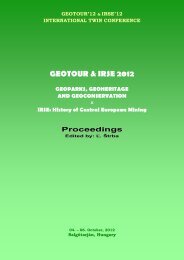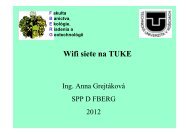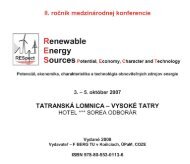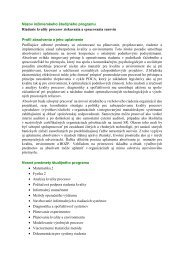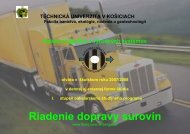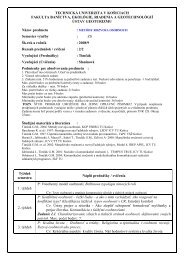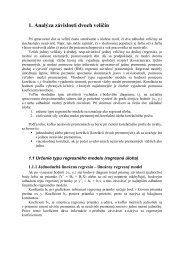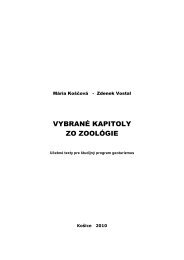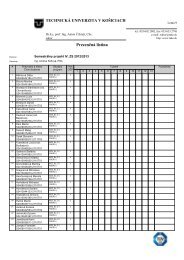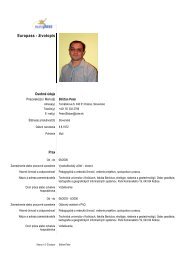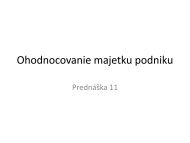GEOTOUR & IRSE 2012.pdf - Fakulta BERG - TUKE
GEOTOUR & IRSE 2012.pdf - Fakulta BERG - TUKE
GEOTOUR & IRSE 2012.pdf - Fakulta BERG - TUKE
You also want an ePaper? Increase the reach of your titles
YUMPU automatically turns print PDFs into web optimized ePapers that Google loves.
<strong>GEOTOUR</strong> & <strong>IRSE</strong> 2012<br />
Fig. 1 The fieldof the Spiń-Gemer part of Slovak Ore Mountains<br />
(Source: Grecula, P. a kol., 1995 : Loņiská nerastných surovín Slovenského rudohoria, zväzok 1, Mineralia<br />
Slovaca – Monografia, Bratislava, 1995, 1 – 829)<br />
LOCATION HISTORY<br />
Mining, Metallurgy and hardware store in Spiń-Gemer Ore Mountains have a rich history. Its<br />
origins are hidden deep in the past, probably to the period of 4-5.stor .. PNLP, as evidenced<br />
by a number of archaeological finds. The development of iron ore mining and iron industry<br />
took place in the Celtic period (350 BC r) and early AD in the Roman period (1-4 century)<br />
and Slavic (5-11 century).<br />
The first written mention of the iron ore mining and processing by the Roman historian<br />
PCTacita already in 11.stor.nl wrote on Kotin, who pay taxes charm and quad form weapons.<br />
Written materials on mining ores in the Spiń-Gemer Rudohorie are old more than 700 years.<br />
During the past century, mining was on the rise and decline. Among other reasons, it had an<br />
impact on the interest in the mining of various ores. Once they were iron ore, copper ever.<br />
Spiń-gemer Ore Mountains is in terms of ores and industrial exploitation of the most<br />
important departments of Slovakia. Quality ore deposits, proximity to forests suitable for<br />
charcoal burning and abundant streams with plenty of power in this area gave rise to mining,<br />
metallurgy and metallurgy. [4]<br />
This area, especially Gemer stool was in the past called Ironworks stool of Hungary.<br />
Great prosperity survived hardware store in the 17 and 18 century in internal wars. In order to<br />
ensure raw material base for the production of armament built the first blast furnace in Gemer<br />
Dobńina, Revúca, Rejdová and Píla. In 1747 was in the county Spisska 34 and 36 Gemerskej<br />
County Ironworks. Gemer Ironworks was the main area of Hungary in the 19th century.<br />
During the years 1804 - 1805 worked 9 furnaces and 81 Slovak furnaces, with an average<br />
annual production of 120 to 150,000 Viennese cents (1 cent = Vienna 56 kg) of iron.<br />
Unique ironworks manufacturing sites in 19 Three centuries preserved blast furnace in Niņná<br />
Slaná Vlachovo and Sirk-Červeņany. Some deposits (eg Smolník) were in the era of a major<br />
European producer of copper ore.<br />
In view of the rich history of mining and processing of copper and iron ore for later Spiń just<br />
this corner of Slovakia, especially the southwestern portion boasts many well-preserved relics<br />
after mining. Not only preserved and renovated galleries mouth, but also for building the<br />
objects contained in mining centers such as towing tower Klopačka mining, building<br />
131



